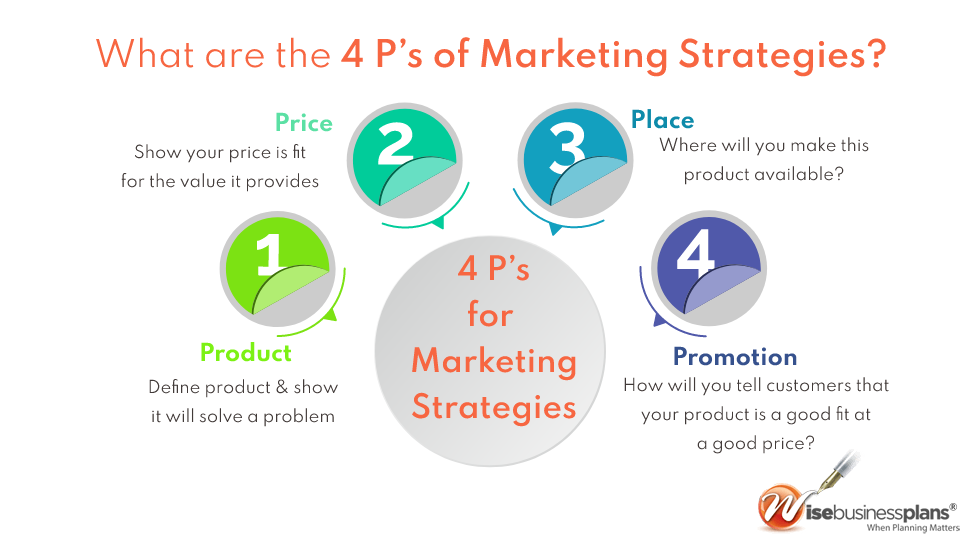Developing An Effective Marketing Strategy | The Four p’s of Marketing
Before you read about the 4 p’s of marketing. lets look at what is marketing.
What is Marketing?
Marketing is defined as putting the right business plan for a product in the right place, at the right time, for the right price for a product. Although this sounds easy enough, a lot of hard work and research usually goes into making this a reality. And if even one element is off the mark, a promising product or service can fail completely and end up costing the company much time and treasure.
What are the Marketing Mix and the 4ps of Marketing?
A marketing mix is a crucial tool for understanding what the product or service can offer and how to plan for a successful product offering. The 4 p’s of marketing was developed over the years by experts to help businesses with the creation and implementation of a Through its’ use, the effort is placed on trying to satisfy both the customer and the seller.
When properly understood and utilized, this mix has proven to be a key factor in a product’s success. An effective marketing mix can mean the difference between a here today and gone tomorrow product or one that is bound to become a time-honored classic. The marketing mix is most commonly executed through the 4 p’s of marketing: Price, Product, Promotion, and Place. These 4 P’s are shown below, along with potential questions for you to consider:
The 4 p’s of marketing
1.Product
The product is either a tangible good or an intangible service that is made to meet a specific customer need or demand. All products follow a life cycle and it is vital for marketers to understand the business planning process for the various stages. It is key to understand those problems that the product is attempting to solve. The benefits offered by the product and all its features need to be fully understood and the potential buyers of the product need to be identified and researched.
2.Price
Price covers the actual amount the end-user is expected to pay for a product. How a product is priced will directly affect how it sells. This is directly associated with the perceived value of the product is to the customer. If a product is priced higher or lower than its perceived value, then it will not sell. This is why it is imperative to understand how a customer sees what you are selling. Price may also be affected by distribution plans and how competitors price a rival product.
3.Promotion
The marketing communication strategies and techniques all fall under the promotion banner. These may include advertising, sales, special offers, and public relations. Whatever the technique used, it is necessary for it to be suitable for the product, the price, and the end-user it is being marketed to. It is important to differentiate between marketing and promotion. Promotion is just the communication aspect of the entire marketing function. Marketing encompasses all four Ps.
4.Place
Place or placement has to do with how the product will be provided to the customer. Distribution is a key element of placement. The placement strategy will help assess what channel is the most suited to a product. How a product is accessed by the end-user also needs to complement the rest of the product strategy. Don’t try selling a 400 dollar pair of shoes at a discount shoe mart.
While entrepreneurs are most likely to hire a professional business plan writer to write a formal business plan when seeking outside funding for their business, such as a bank loan or venture capital, planning your business is important before you start, whether or not you need funding.
The Role of Marketing in Busines Planning
Suppose you wanted to take a trip to Yellowstone National Park. You would likely plan many aspects of your trip before you even leave your home. You would need to decide whether to drive or fly. If you drive, you would need to determine the best route to get there (or have a GPS that can do that for you).
If you fly, you would need to look at flights around the days you hope to visit and then book one, as well as consider various options for land transportation once you arrive. You would also need to plan your lodging, including whether to camp, rent a cabin, or get a hotel room. If you go during the summer, when Yellowstone gets the most visitors, you would likely need to decide on your lodging ahead of time and make reservations to ensure your overnight preference is available.
Just like a trip to Yellowstone would require advanced planning to maximize the likelihood of it being a rewarding experience, planning your business in advance is necessary to maximize your likelihood of success. So, what are some of the things that should be considered when planning your business? While there are numerous ways to go about planning, one option is to consider the 4 P’s of Marketing (sometimes called the “Marketing Mix”).
With so much focus on business planning before you launch your business, does this mean that your plan must be etched in stone and that you should never be open to change? No! Assessing your operations and adjusting your strategies will be an ongoing process if you want to maximize your company’s potential.
In fact, one of the downsides to any business plan is that it will likely need to be updated every few months. You may discover that some of your marketing tactics are more effective than others and need to adjust your marketing campaign. You may discover that the demographics of your customer base are different from what you expected, and you may need to reconsider your target market. If you are offering more than one product or service, you may discover that some of your products or services generate more demand than others, and you may need to tweak your offerings.
Whether visiting Yellowstone or starting a business, it is important to develop a plan before you embark on your journey. However, it is also important to be flexible as you implement your strategy and be open to change.
FAQs:
The four P’s of marketing are product, price, place, and promotion. These elements help businesses develop an effective marketing strategy by focusing on product attributes, pricing strategies, distribution channels, and promotional activities.
Product refers to the goods or services offered by a business. It is crucial in a marketing strategy as it defines the value proposition, target audience, and differentiation from competitors. Understanding customer needs and developing a compelling product is essential for successful marketing.
Pricing plays a vital role in a marketing strategy as it directly affects customer perception, demand, and profitability. Setting the right price requires considering factors such as production costs, competitive pricing, value to the customer, and pricing strategies that align with business goals.
Place refers to the channels and methods used to distribute and make products or services available to customers. Effective distribution ensures that the right products are in the right place at the right time, making it convenient for customers to access and purchase them.
Promotion involves the communication and promotion of products or services to the target market. It includes advertising, public relations, sales promotions, and other promotional activities. Promotion helps create awareness, generate interest, and persuade customers to choose the product or service over competitors.













